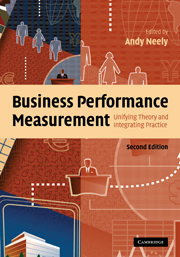Book contents
- Frontmatter
- Contents
- List of figures
- List of tables
- List of boxes
- List of contributors
- Introduction
- Part I Performance measurement – functional analyses and theoretical foundations
- Part II Performance measurement – frameworks and methodologies
- 7 Performance measurement frameworks: a review
- 8 Beyond budgeting to the adaptive organization
- 9 Theoretical conditions for validity in accounting performance measurement
- 10 The validity of measurement frameworks: measurement theory
- Part III Performance measurement – practicalities and challenges
- Part IV Performance measurement in public services
- Part V Performance measurement – emerging issues and enduring questions
- Index
- References
7 - Performance measurement frameworks: a review
Published online by Cambridge University Press: 22 September 2009
- Frontmatter
- Contents
- List of figures
- List of tables
- List of boxes
- List of contributors
- Introduction
- Part I Performance measurement – functional analyses and theoretical foundations
- Part II Performance measurement – frameworks and methodologies
- 7 Performance measurement frameworks: a review
- 8 Beyond budgeting to the adaptive organization
- 9 Theoretical conditions for validity in accounting performance measurement
- 10 The validity of measurement frameworks: measurement theory
- Part III Performance measurement – practicalities and challenges
- Part IV Performance measurement in public services
- Part V Performance measurement – emerging issues and enduring questions
- Index
- References
Summary
Introduction
The shortcomings and dysfunctional consequences of performance measurement systems have been discussed in the academic literature for at least fifty years (Ridgway, 1956), but recently there has been a flurry of activity. Throughout the 1980s vocal and influential authors criticized the measurement systems used by many firms (Johnson and Kaplan, 1987; Hayes and Abernathy, 1980). By the 1990s the noise made by these voices had grown to a crescendo (Eccles, 1991; Neely, Gregory and Platts, 1995), and increasing numbers of firms appeared to be “re-engineering” their measurement systems, with data suggesting that, between 1995 and 2000, 30 to 60 per cent of companies transformed their performance measurement systems (Frigo and Krumwiede, 1999). By 2001 the balanced scorecard had been adopted by 44 per cent of organizations worldwide (57 per cent in the United Kingdom, 46 per cent in the United States and 26 per cent in Germany and Austria). More recent data suggest that 85 per cent of organizations should have had performance measurement system initiatives under way by the end of 2004 (Rigby, 2001; Silk, 1998; Williams, 2001; Speckbacher, Bischof and Pfeiffer, 2003; Marr et al., 2004). However, cautionary evidence was reported by three Austrian academics to the effect that 8 per cent of 174 companies from German-speaking countries decided not to implement a performance measurement system (and a balanced scorecard in particular) because they could see no advantages or “positive impact” for themselves, especially given the implementation effort required (Speckbacher, Bischof and Pfeiffer, 2003).
- Type
- Chapter
- Information
- Business Performance MeasurementUnifying Theory and Integrating Practice, pp. 143 - 162Publisher: Cambridge University PressPrint publication year: 2007
References
- 14
- Cited by



